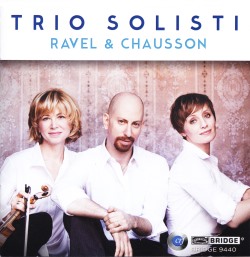
|
Maurice RAVEL (1875-1937)
Trio in A minor (1914) [26:29]
Ernest CHAUSSON (1855-1899)
Trio in G minor, Op. 3 (1881) [30:04]
Trio Solisti (Maria Bachman (violin); Alexis Pia Gerlach (cello); Adam Neiman (piano))
rec. 16-18 December 2013, The Performing Arts Center, Purchase College, New York, USA
BRIDGE 9440 [56:40]
The New York-based Trio Solisti has chosen to perform two of the most attractive works in French chamber repertoire. The Ravel Piano Trio is one of the most renowned works in all French chamber music whilst Chausson’s early Piano Trio, although exceptionally fine, is much lesser known.
Prior to the foundation of the Société Nationale de Musique in 1871 the chamber music performed in France had been the preserve of the Austro-Germans especially Beethoven. Crucially the Société Nationale de Musique was established by Romain Bussine, Camille Saint-Saëns and Henri Duparc to encouraged native French composers. In this field Saint-Saëns was in the vanguard and highly prolific too, writing some fifty chamber scores including the Piano Trio No.1, Op. 18 from 1863 and the Piano Trio No.2, Op. 92 dated 1891.
Ravel’s highly acclaimed Trio for piano, violin and cello in A minor was written in the summer of 1914 at the Basque retreat of Saint-Jean-de-Luz, whilst on holiday with friends. Although influenced by the joyous piano trios of Saint-Saëns this work betrays the looming spectre of the Great War, but Ravel could not have known the extent of the horrors to come. Musicologist David Ewen described the score as “a work reduced to essentials. It is a masterpiece of form and technique in its avoidance of all superfluous details.”
The Trio Solisti fondly performs the Piano Trio with its suggestion of Basque themes hauntingly exploring the contrasts of sonorities between piano and strings. The relatively lengthy opening movement with its ingenuity of structure and originality of design is given an interpretation that radiates dreamy sensitivity. It is almost like the tentative beginnings of a heady romance. Played with remarkable fluidity the Scherzo-like second movement titled Pantoum: Assez vif thrives with nervy vitality. Inhabiting a serious mood the Passacaille: Très large with its opposing sonorities of piano and strings is marked with an engaging lightness reminiscent of a daydream. Quasi-orchestral in conception the tempestuous Finale: Animé is passionate love music played here with precision and unfailing understanding.
Unlike Ravel’s mature Piano Trio that of his predecessor Chausson is the work of a relative beginner. His first chamber piece, Chausson composed his underrated Trio in 1881 after a period of study at the Paris Conservatoire with Massenet and Franck. It drew little or no attention at its première in Paris and was published posthumously. In the Cobbett Cyclopedic Survey of Chamber Music (1929) the author saw the promise of the work: “In this work, amidst its beauties and its weaknesses, one already feels the aspirations, as yet unrealized, of an artist-soul, whose loftiness of thought foreshadows works in which he will come to his own.”
Thickly scored and squally in character, the extended opening movement marked Pas trop lent - Animé with its abrupt dynamic changes and increasing passionate intensity is played by Trio Solisti with verve and compelling expression. There's refreshing exuberance also in the second movement Vite — a short and delightful, if rather four-square Scherzo. Imbued with a sense of love and longing the intense third movement Assez lent is given playing of satisfying concentration. The final unrelentingly passionate Animé is windswept with a deceptively simple opening. It quickly darkens becoming more complex. The praiseworthy Trio Solisti give a confident interpretation: insightful and rewarding.
Throughout both works the unity of the playing is securely formed with an attractive timbre from both piano and strings.
With regard to competing versions the Ravel has been extremely popular in the recording studio and the Chausson rather less so. As to the Ravel I favour the stunningly played 2001 recording from Frank Braley with Renaud and Gautier Capuçon on Virgin Classics. It's brimful of polished expression. In the Chausson, a favourite account for its unerring sensitivity, is from Pascal Rogé, Mie Kobayashi and Yoko Hasegawa recorded at La Chaux-de-Fonds, Switzerland in 2002 for Onyx.
Bridge is to be congratulated for this well presented release. The engineers provide impressively clear and well balanced sound. On the minus side, at under an hour, the disc is not generous by today’s standards and could have accommodated another work such as the Fauré Piano Trio, Op. 120 or D’Indy Piano Trio No. 2, Op. 98.
Trio Solisti is a noteworthy advocate for this pair of wonderful French scores. I hope that they turn their attention to English piano trios such as Stanford, Bridge, Ireland and Bax.
Michael Cookson
 |
 |
|
